Hello and welcome! In this article, I’ll be introducing you to the fascinating world of North American finches.
With 11 different types of finches found in North America, these small and colorful birds are a joy to observe and study.
From the iconic American goldfinch to the lesser-known purple finch, each species has its unique characteristics and adaptations that allow them to thrive in their environments.
Join me as we explore the diverse and wonderful world of North American finches!
| Image | Name |
|---|---|
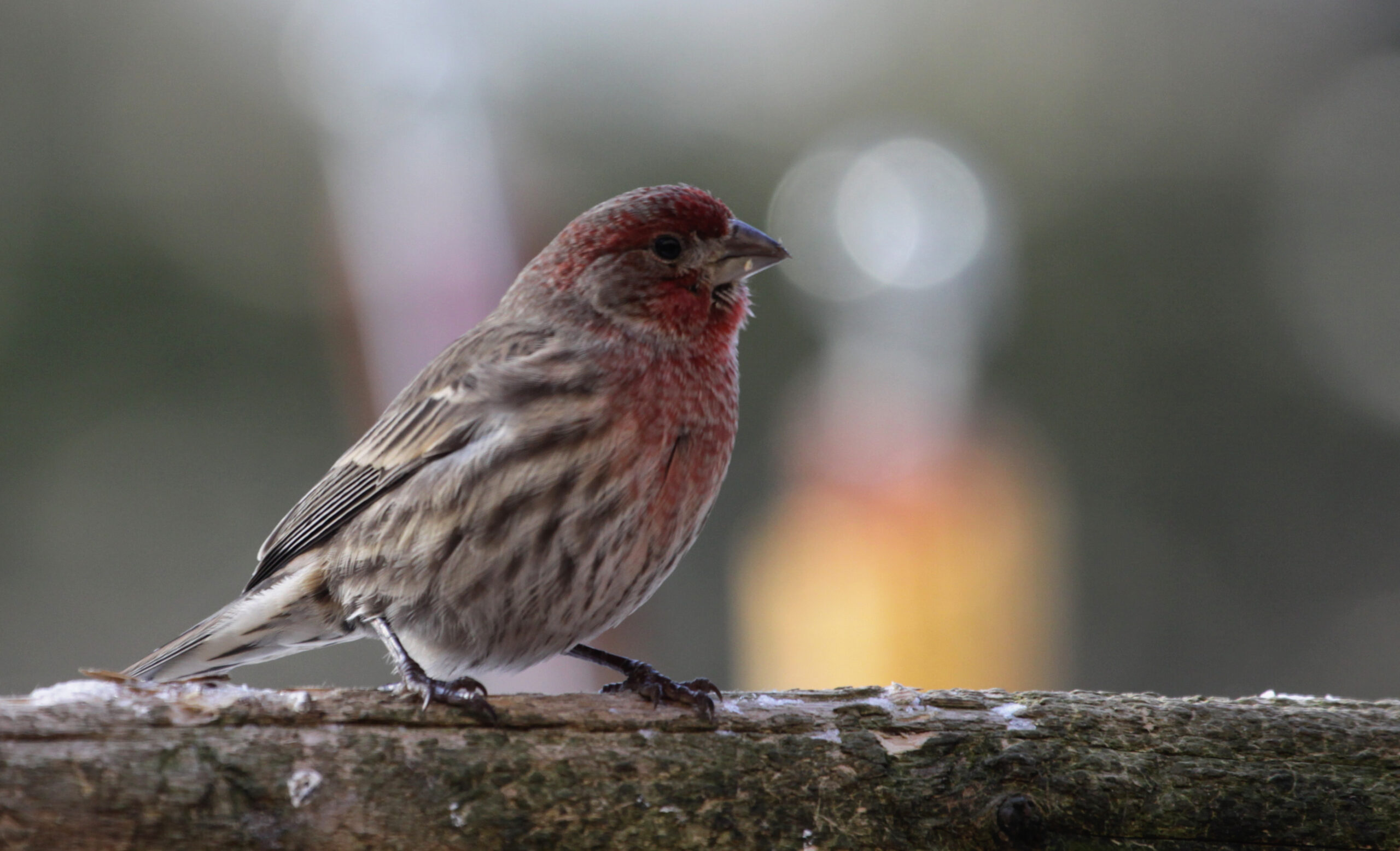 | House Finch |
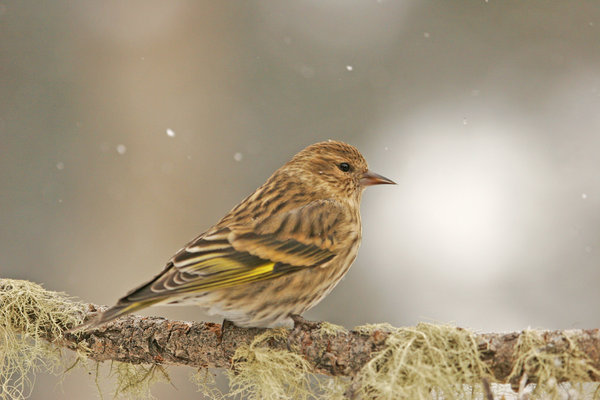 | Pine Siskin |
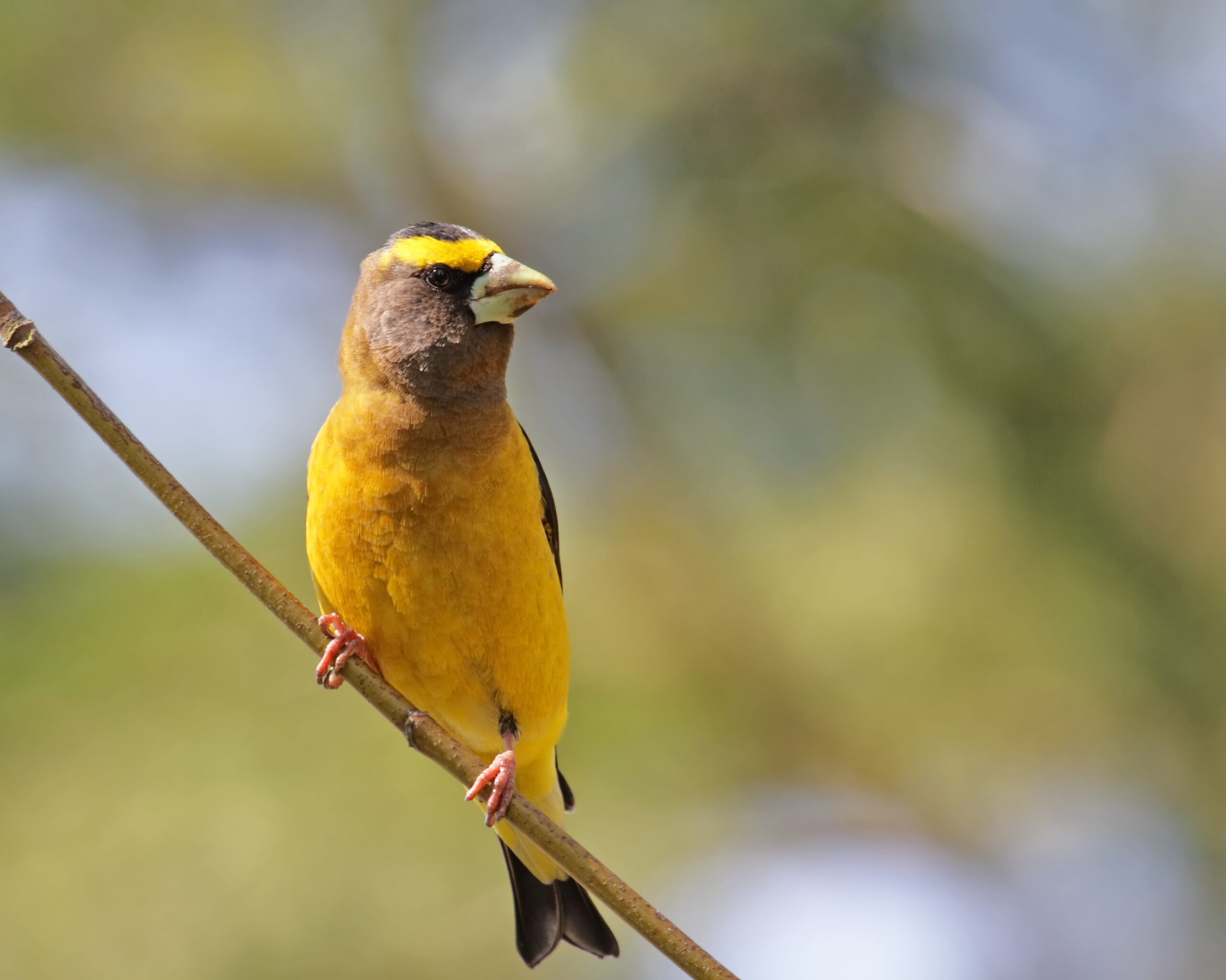 | Evening Grosbeak |
 | Purple Finch |
 | Rose-breasted Grosbeak |
 | Common Red pole |
 | Cassin's finch |
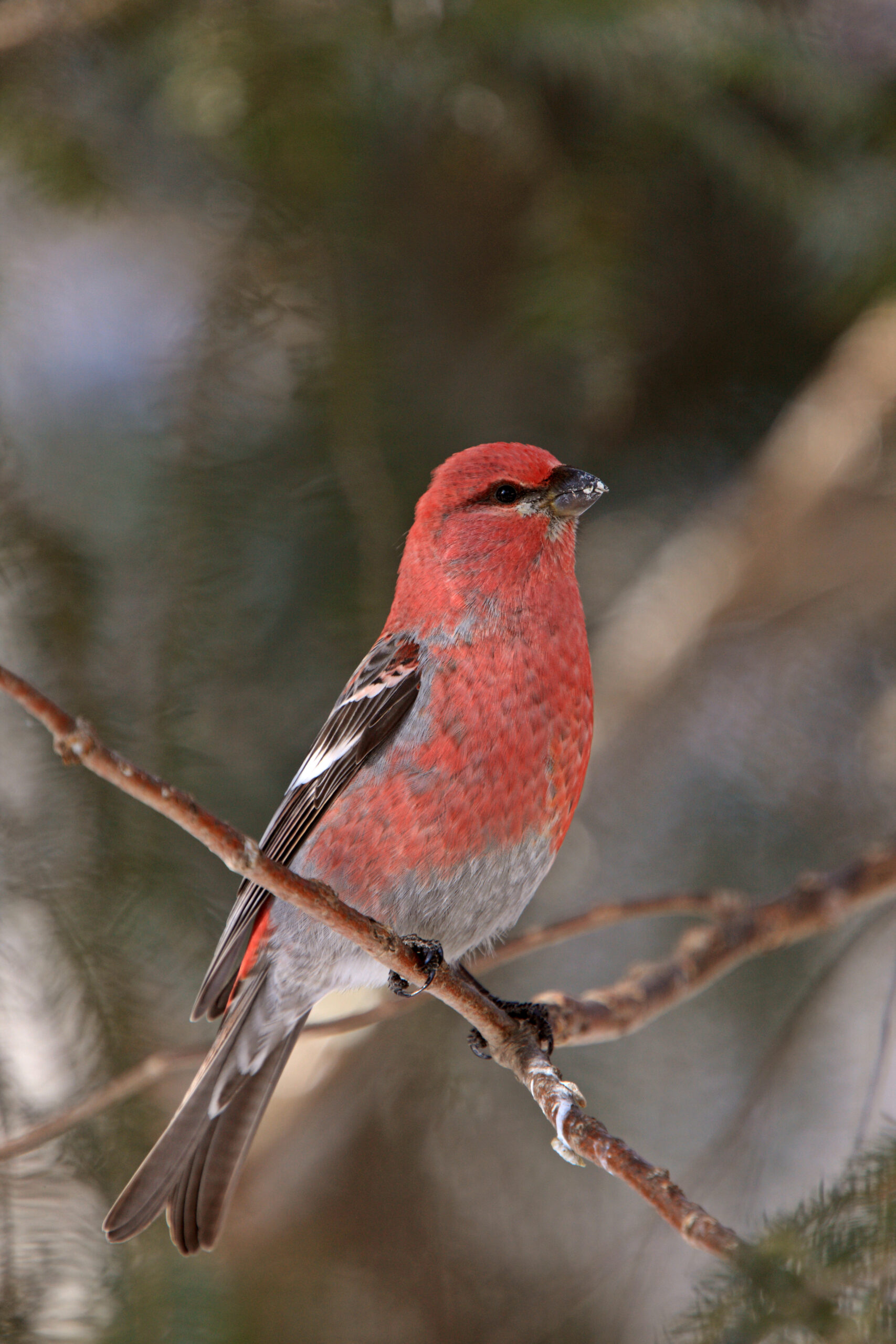 | Pine Grosbeak |
 | Hoary Redpoll |
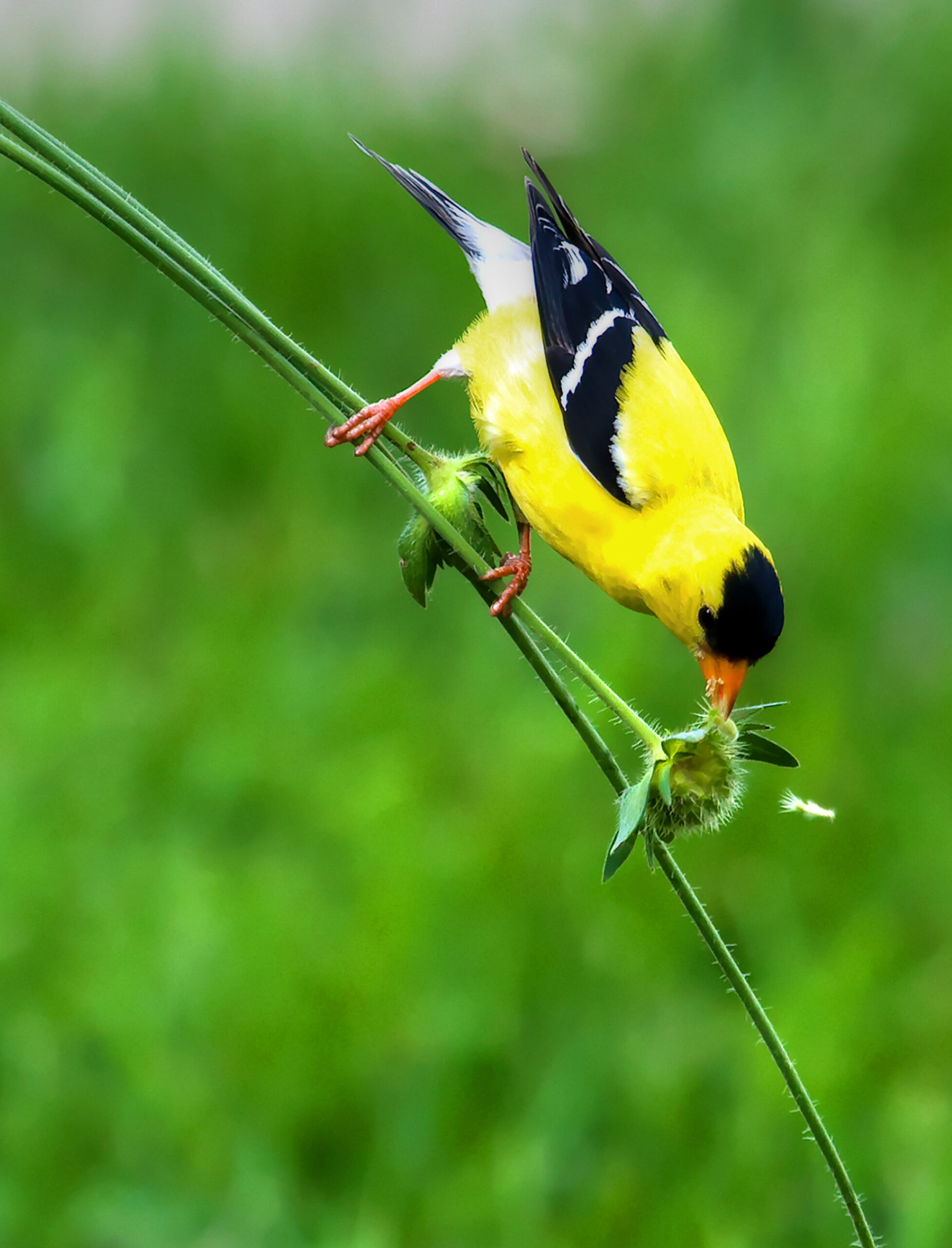 | Lesser Gold Finch |
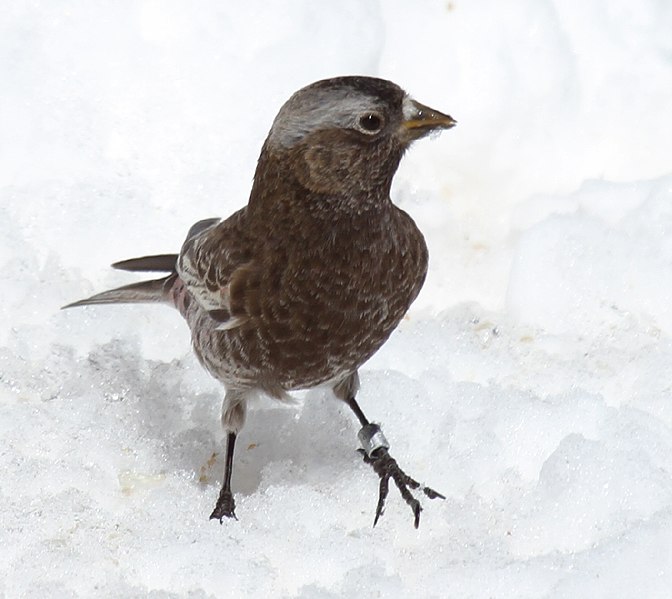 | Black Rosy-Finch |
Types of Finches in North America
1. House Finch
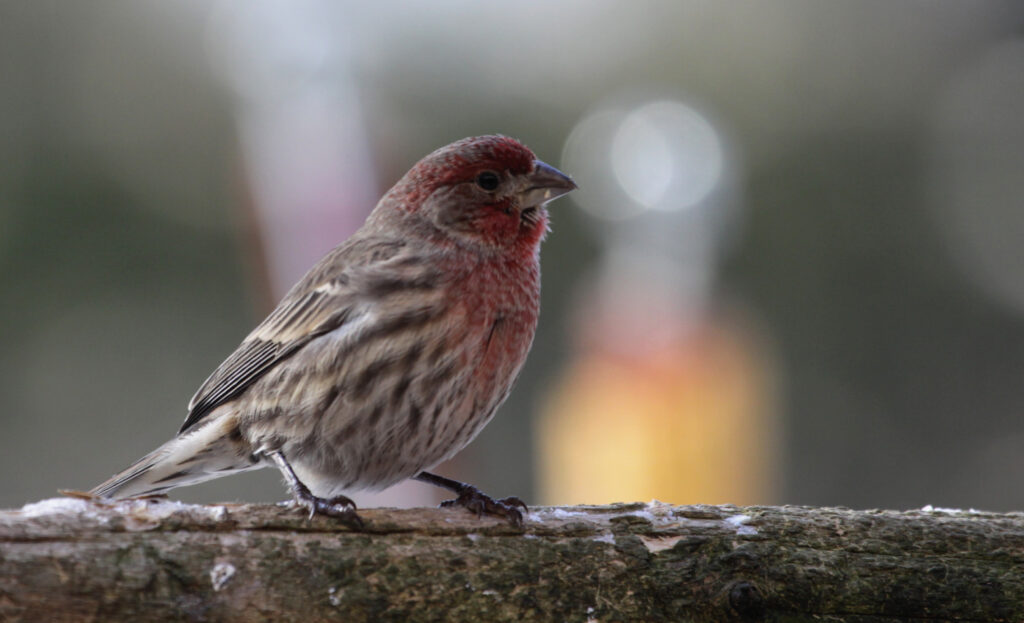
Male House Finches possess a red chest and head, while the remainder of their brown-streaked bodies is mostly streaked with brown.
The females are completely covered with brown streaks.
House Finches were exclusively found in the western regions of the United States at one point, but they were later imported to the eastern states, where they have flourished so much that they have driven the Purple Finch to extinction.
House Finches like to congregate in loud flocks and may be heard calling to one another in backyards, farms, and parks, as well as along the margins of forests.
They consume buds, seeds, and fruit for food.
Nests of House Finches may be discovered in a variety of habitats, including natural hollow spaces, shrubs, thickets, and even structures.
It is the female who constructs them of things like leaves, grass, feathers, and twigs.
There may be 2 to 6 eggs present at a time, and it may take up to 2 weeks for the eggs to hatch.
Tube feeders or platform feeders filled with millet, black oil sunflower seeds, and nyjer or milo seeds are the best way to entice house finches to your garden.
Caged House Finches were introduced to the population of Long Island.
After being let free in the wild, they quickly became thriving populations that quickly expanded over the eastern United States.
2. Pine Siskin

Pine Siskins are little brown finches that have yellow streaks running down the tail and wings.
They possess a small, pointy beak in addition to their pointed wings and forked tails.
Pine Siskins spend the whole year in the pine woods of western states and near the border with Canada.
Additionally, they reproduce across Canada before migrating south for the winter.
They may be found across most of North America, however, their distribution is highly dependent on the availability of pine cone crops.
Pine Siskins get the majority of their nutrition from the seeds of conifers, as their name may imply, although they will also consume the early seeds and buds of weeds and grasses.
Nests of Pine Siskins are typically constructed 10 to 50 feet above the ground and distant from the main stem of the tree.
In most cases, they are constructed from moss, twigs, and bark, and they may hold anywhere from 3 to 5 eggs.
The eggs will hatch after roughly a week and a half has passed.
Feeders filled with suet and black oil sunflower seeds, in addition to nyjer and thistle, can entice pine siskins to visit your gardens.
The chirping sound that the Pine Siskin makes inspired the naming of this bird. In other words, it sounds like a “pine chirper.”
3. Evening Grosbeak

Evening Grosbeaks are large, stocky birds having disproportionately large bills and a distinctive combination of yellow and black.
The adult males possess a brilliant yellow stripe that runs across their eyes, giving them a menacing appearance.
Their heads are dark, while their chests and necks are grey, and their chests and bellies are yellow.
In addition, each of their wings has a white spot on it.
Females and immature males have bills that are a bluish-green color, bodies that are predominantly grey, wings that are white and black, and a yellowish tint to the throat.
Evening Grosbeaks are found year-round throughout the southern portion of Canada and all the way across the west coast towards northern California.
However, when there aren’t enough cones to go around, they go south to the majority of the states in the United States.
Forests and mountainous terrain are the best places to look for Evening Grosbeaks.
In the winter, they are often drawn to the bird feeders that are placed in gardens, and the primary reason for this is that the feeders provide easy access to a source of food.
During the early evening, Grosbeaks have a natural diet that consists of flower buds in the springtime, insect eggs from treetops in the summer, and tiny fruit, seeds, and berries in the wintertime.
During the spring season, they congregate at garden feeders to consume bug larvae.
The nests of Evening Grosbeaks are often located in pine trees at heights of up to 100 feet above the ground.
The nests are haphazardly constructed and comprised of rootlets, moss, twigs, pine needles, and grass, among other materials.
Typically, the female will lay anything from 1 to 5 eggs, which she will then tend to for the next 2 weeks until they are ready to hatch.
Maple buds, berries, and sunflower seeds are three foods that can entice Evening Grosbeaks to spend the winter in your garden.
Evening Grosbeaks possess such strong bills that they are able to break seeds that are difficult to open for all other birds.
Because of this, these birds stick around to consume whatever is left over after the other birds have finished eating.
4. Purple Finch
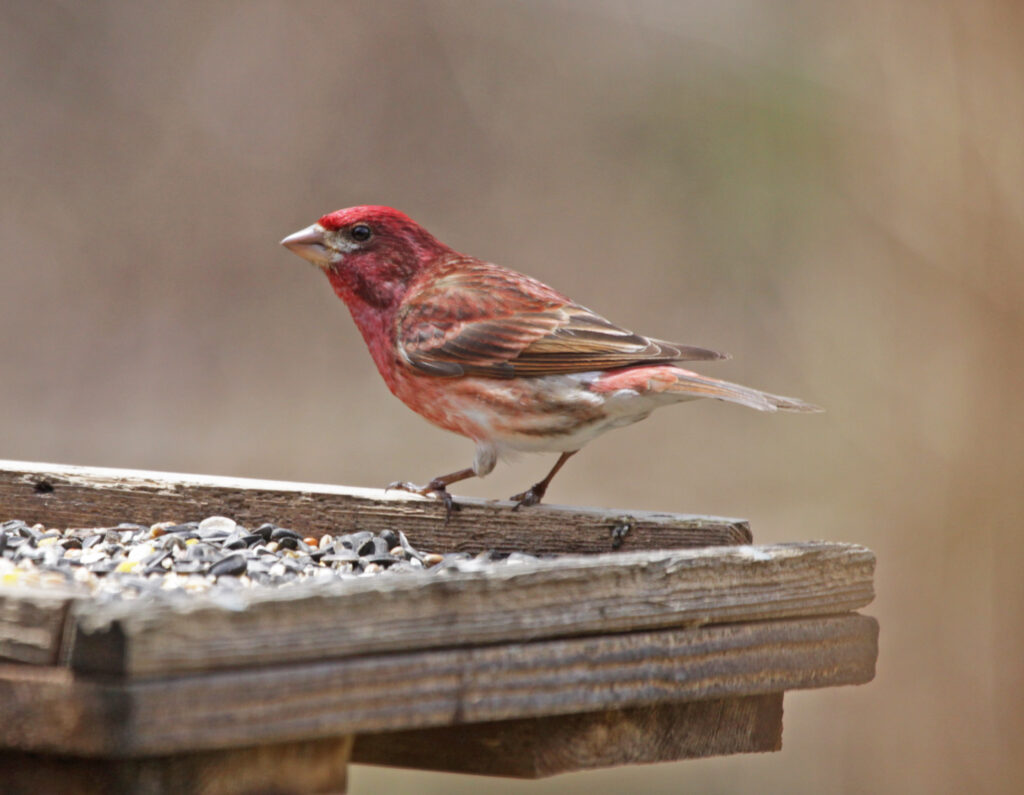
Finches of a Violet Fleck Males possess heads and chests that are more of a reddish-purple color, while their wings and backs are browner, and their bellies are lighter.
The females have brown spots all over their bodies.
They have a fairly similar appearance to the House Finch, but their backs, particularly the tops of their heads, are much redder.
Although they breed across Canada and spend the winter in the eastern states, Purple Finches may be observed throughout the northeast and along the Pacific coast throughout the whole year.
The Purple Finch is a woodland bird that lives among evergreen woods and feeds mostly on seeds but sometimes consumes berries, buds, and nectar.
Nesting territories of Purple Finches are often found in the canopy of trees.
They are constructed of bark, weeds, and twigs in addition to moss.
They typically carry anything from 3 to 5 eggs, which the female incubates for a period of 13 days.
Black oil sunflower seeds are an excellent way to bring Purple Finches to your yards and gardens.
The Purple Finch is the official bird of the state of New Hampshire.
5. Rose-breasted Grosbeak

The Rose-breasted Grosbeak is a stout, medium-sized songbird with a massive, triangle bill.
They have a squared-off, medium-length tail that contrasts with their short neck and large breast.
The adult males of this species are white and black, with a striking red chevron running from the black of the neck to the white of the chest.
Brown and strongly streaked, having a prominent white stripe above the eye, females and juveniles have this appearance.
Males have a reddish-pink flash beneath their wings, while females have a yellowish one.
White spots may be seen on the tails and wings of both sexes.
Feeding on insects, nuts, and fruit, these stocky birds have robust bills.
These birds are regulars at garden bird feeders, wherein they gorge themselves on sunflower seeds.
Male Rose-breasted Grosbeaks are a common sight in eastern woodlands, where they sing a lovely, meandering melody.
They also make piercing, unique “chink” cries.
Breeding Rose-breasted Grosbeaks may be found in eastern woodlands, where they forage among both deciduous and coniferous trees.
They congregate mostly in parkland and regenerating forests.
In order to fuel their journey to South and Central America, migrating Rose-breasted Grosbeaks often stop at fruiting trees.
6. Common Red Pole

The tiny bills of Common Redpolls need the consumption of tiny seeds.
Nyjer and thistle feeders are where you’re most likely to encounter them, but they’ll eat everything from black oil sunflower to scavenged seeds left behind by larger-billed birds.
Certain Common Redpolls may even dig burrows in the snow to keep warm at night during the winter season.
The tunnels might well be longer than a foot and buried at least four inches in the fluffy white stuff.
Redpolls may temporarily store seeds in their neck pouches.
Birds may swiftly stuff their pouch with seeds before taking off for a safer, warmer location to eat them.
The eldest Common Redpoll ever recorded lived for at least eight years and ten months.
It was hurt in 1990 when a cat captured it in Alaska.
Miraculously, it managed to pull through despite the damage it took.
For most individuals across North America, the only time they see Common Redpolls is in the wintertime when the birds visit feeders or graze for tiny seeds in forests or weedy areas.
Please pay attention to the chattering and trills they make and the buzzing, shrill call notes they use.
Remember that they frequently gather in large flocks that appear to be in continual motion.
7. Cassin’s Finch

Male Cassin’s Finches are distinguished by their white bellies, bright red breasts, and brown wings and backs, as well as their distinctive red crowns and pink heads.
Females and babies have brown spots all over their bodies.
The mountain woods of the western United States and southwestern Canada are home to the year-round Cassin’s Finch population.
The colder months see a seasonal exodus to northern Mexico.
Cassin’s Finches may be seen searching for food in flocks among the seeds of fir trees.
In addition to eating insects like moths, they also like quaking aspen bud nectar, berries, and other types of food.
Cassin’s finches often construct their nests among pine or other trees.
Twigs, reeds, barks, and rootlets are used to construct cup-shaped nests.
From 4 to 6 eggs may be laid in a nest, and the female will tend to them for approximately 2 weeks.
Sunflower seed feeders, particularly in the winter, and fruiting shrubs like pulsions such as grapes, mulberries, cotoneaster, apple, and firethorn may entice Cassin’s Finches towards your gardens.
You can be confused with the male Cassin’s Finch.
For the first year of its breeding life, it keeps the color and patterning of its feathers that are typical of females.
8. Pine Grosbeak
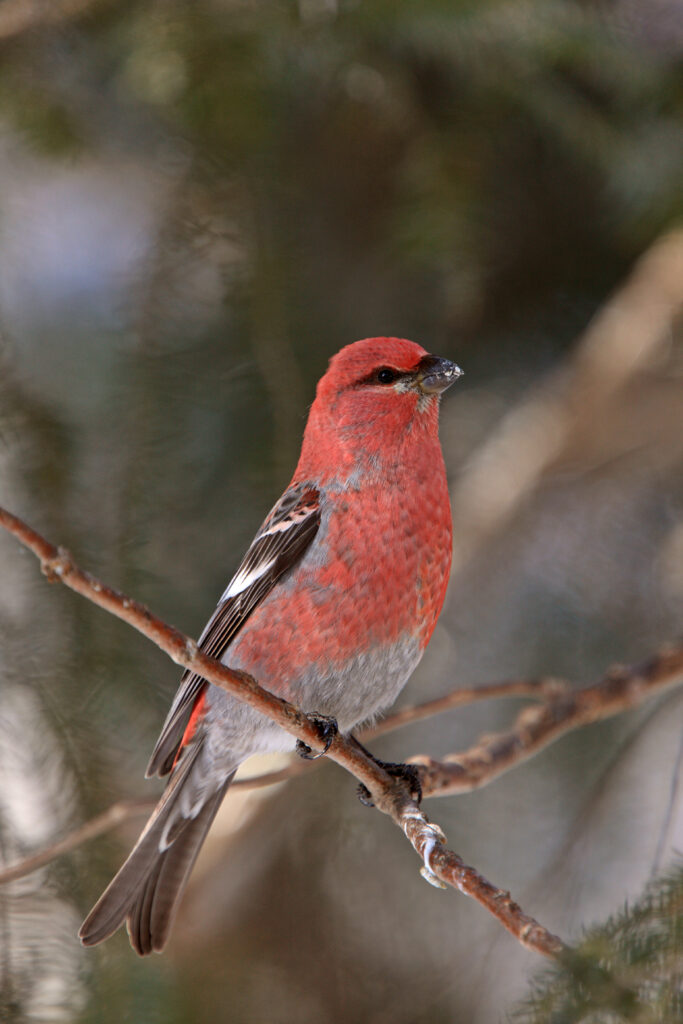
The male Pine Grosbeak is distinguished by his bright red plumage, greyish tail and wings, and two white wing bars.
Women are mostly grey, having dull orange on their heads and sides.
Although Pine Grosbeaks are more common across Canada, it is possible to see them in the western United States, particularly in the Sierra Nevada.
Pine grosbeaks are found among spruce, pine, and fir woods, where they feast on the buds, seeds, and fruit of these coniferous trees.
During the summer, they’ll consume bugs too.
Pine grosbeaks often build their nests in low trees, around 10 to 12 feet from the ground.
Two to five eggs are housed in these nests, which are woven together from various plant materials, including moss, bark, twigs, lichen, and weeds.
After laying her eggs, the female waits for around two weeks for them to hatch.
Black oil sunflower seed feeders and suet feeders will bring Pine Grosbeaks to your gardens.
Pine grosbeaks live up to their name.
Their genus name, Pinicola, means “pine dweller” in Latin.
9. Hoary Redpoll

Hoary Redpolls are robust little birds. Most males are white with a crimson stripe on their foreheads.
Male adults have rosy chests, but female adults do not.
When comparing males and females, it is clear that the latter have more stripes on their stomachs.
The appearance of juveniles is drastically different; they are primarily grey with extensive streaking, and they lack the red spot on the forehead seen in adults.
Hoary Redpolls are arctic migrants that only go small distances south to spend the winter.
During the summer, Hoary Redpolls may be seen in both closed tundra birch woods and open subarctic tropical rainforests.
Scrub, weedy meadows, and open forests are where you’ll find them throughout the winter when they’re closest to human habitation.
Alder and birch tree seeds, as well as insects, make up the bulk of their diet.
The Hoary Redpoll builds its nests in inconspicuous places, such as rock outcroppings, tree cavities, and thickets of bushes.
Twigs, grass, and rootlets provide the framework for the nest, which is then padded with grass plumage and animal hair.
Approximately five eggs are laid, and the chicks emerge from their shells about ten days later. In around two weeks, the babies will have fled the nest.
Hoary Redpolls may often remove feathers from their bodies if the temperature rises beyond a certain threshold.
Do not fret; they will regenerate.
10. Lesser Gold Finch
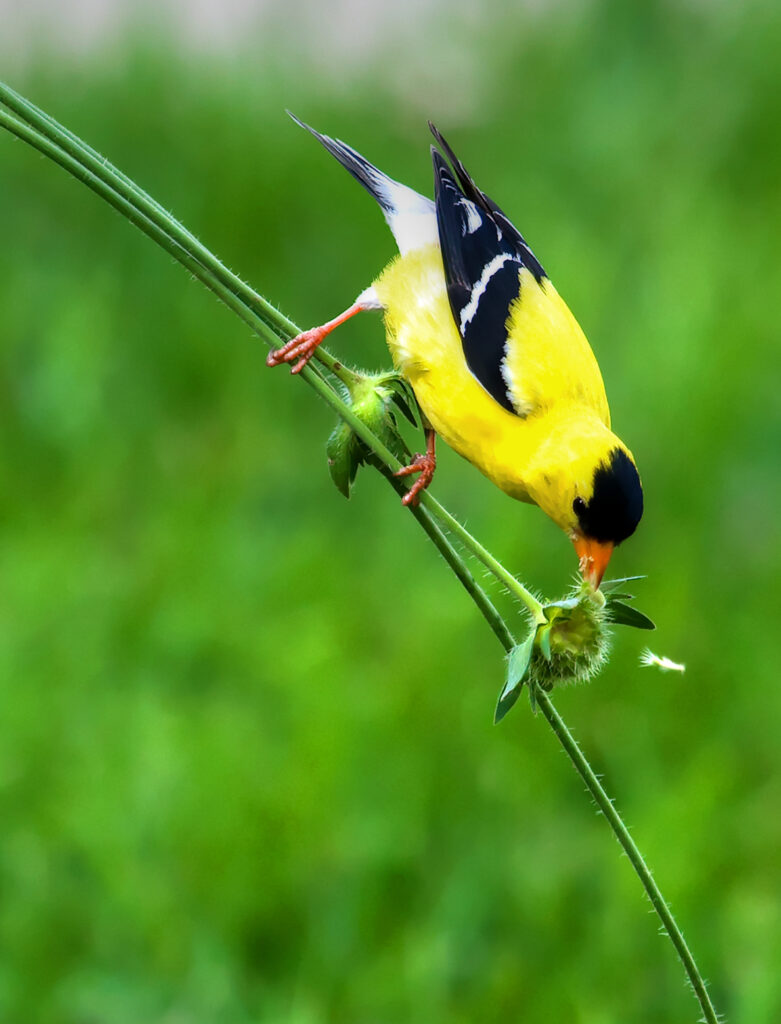
The Lesser Goldfinch is a little songbird having a short beak, long pointed wings, and a short tail with a slit at the end.
Males may be either glossy black or dull greenish on the rear, while the front is a brilliant yellow having a glossy black cap and white spots in the wings.
The corners of their black tail are rounded off with white.
Unlike males, females and juveniles possess pale yellow bellies, olive backs, and black wings with two white wing bars.
Hundreds of Lesser Goldfinches have been seen at one location.
Both in weedy areas and at bird feeders, they eat grains and seeds.
At bird feeders, in particular, their flocks will mingle with other seed-eating songbirds.
Lesser Goldfinches may be seen foraging in blossoming trees, weedy fields, and the undergrowth around open areas and margins.
They are most frequent in suburban areas, but they can also be found among mountain valleys and desert oasis communities.
11. Black Rosy-Finch

The crown of a Black Rosy-Finch, which is often greyish white, stands out against the black background of its otherwise all-black head.
Their brownish-black skin has pink stripes on the abdomen.
Blacker plumage on breeding adults highlights the bright pink stripes on their bellies and wings.
Typically, juveniles have a browner appearance.
The Black Rosy-Finch is a common sight in the grasslands and alpine tundra.
Wintertime may find them at lower elevations and open areas, but otherwise, they prefer snowfields and rocky peaks.
The highest points of mountains, rock formations, and cliffs provide the ideal conditions for their nesting.
Black Rosy-Finch feeds on leaves, worms, insects, seeds, and young plants throughout the summer.
They subsist mostly on seeds throughout the winter.
The Black Rosy-Finch builds its nests in inhospitable areas like boulder clefts and cliffside nooks.
The female constructs the nest by weaving together various plant and animal fibers and plumage.
Between 3 and 4 eggs will be laid by her, and they will develop into chicks in around two weeks.
Three more weeks pass until the babies leave the nest.
The Black Rosy-Finch has a special pouch at the base of its beak for storing food for its young.
Conclusion
In conclusion, the 11 types of finches found in North America are a testament to the incredible diversity of bird species on our continent.
From their colorful plumage and unique songs to their incredible adaptations for survival, these birds are a joy to observe and appreciate.
Whether you’re a seasoned birder or simply someone who enjoys nature, taking the time to learn about and appreciate these small but mighty birds can be a rewarding and enriching experience.
So next time you’re out in nature, keep an eye and ear out for the many types of finches that call North America home – you might just be surprised at what you discover!
FAQ
What is the most common type of finch in North America?
The most common type of finch in North America is the American goldfinch.
Where do finches in North America typically live?
Finches in North America can be found in a variety of habitats, including forests, fields, wetlands, and even urban areas.
What is the difference between a finch and a sparrow?
Finches are a type of bird that is known for their colorful plumage and unique songs. Sparrows, on the other hand, are small, drab birds that are known for their distinctive hopping movements.
How can I attract finches to my backyard?
To attract finches to your backyard, you can provide food sources such as birdseed, thistle, and sunflower seeds. You can also provide nesting boxes and water sources to create a welcoming environment for these birds.
Are all types of finches in North America migratory?
Not all types of finches in North America are migratory. Some species, such as the American goldfinch, are year-round residents, while others, such as the pine siskin, migrate south during the winter months.
Last Updated on May 12, 2023 by Lily Aldrin
